Inside The New York Botanical Garden
Posted in Exhibitions, Holiday Train Show on January 6 2009, by Plant Talk
 |
Gingerbread Adventures in the Everett Children’s Adventure Garden includes a display of detailed and fragrant gingerbread creations by renowned pastry chefs in and around New York. Here Leslie Randazzo, co-owner with her husband, Mark Randazzo, of Mark Joseph Cakes, describes how they conceptualized and executed their design.
|
Although Mark and I had never worked with gingerbread before, we were so enthusiastic about making our gingerbread debut in The New York Botanical Garden’s annual holiday exhibit. Yes, Mark is a pastry chef, but he specializes in custom cakes, so this was quite different.
This year’s theme, “Gingerbread People at Work and at Play,” left us wondering “What do gingerbread people do?” I called my nephew, Harry, whose immediate response was, “the same things we do.” Aha! Brilliant! With our target audience being kids, we thought about careers revered by children. It was my sister who suggested firemen. Then we were on a roll. Mark and I share a love for New York City’s pre-war architecture, so there was no question that we’d model our main structure after an old FDNY house. Through research, Mark found one in Manhattan on Lafayette Street that is stunning.
Our next order of business was a crash course in gingerbread structures, namely, keeping them up. For this, Mark made an icing that was similar in consistency to cement. We cut the gingerbread dough into the dimensions that were already carefully calculated. These large pieces make up the main structure. Then we cut gingerbread dough into equally sized rectangles. These were used as a second layer, to achieve the stones the building is made of. Laying the “stones” was extremely time consuming, because the firehouse had so many dimensions and different shapes to work around and each “stone” had to be trimmed to fit precisely in the appropriate space. The windows were made using a sculptor’s molding material that we melted and poured into the gingerbread’s square openings. As it dried, it solidified beautifully. To light the inside, we used LED Christmas lights that we clipped short. For the roof, we thought the perfect candy would be bite-sized black licorice that we would line up to look like shingles. Unfortunately, after placing on more than half of the licorice we discovered that the oily coating used to keep the pieces from sticking together in the package were also keeping them from sticking to the icing. The solution was Nilla® wafers. We were concerned that they wouldn’t cut easily with a knife, but they worked quite well.
Once the main structure was completed, we began adding the details. Red Twizzlers® were used for each window frame, and icing was piped on to create the appearance of snow. The fire truck was decorated using a sugar dough called “gum paste.” Then we designed the wintry fun that one notices when examining the display closely such as the snowball fight and the boy making a snow angel as the firemen look on.
This entire experience was so rewarding; it felt like a tremendous accomplishment after a total of 70 hours of labor. It was great fun and well worth the effort.
Posted in Gardening Tips on January 5 2009, by Sonia Uyterhoeven
Fragrant Wintersweet (Chimonanthus praecox)
 Sonia Uyterhoeven is Gardener for Public Education at The New York Botanical Garden.
Sonia Uyterhoeven is Gardener for Public Education at The New York Botanical Garden.
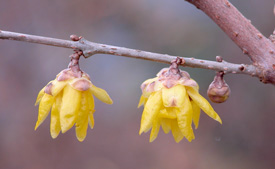 They say that nature is about observation, but sometimes it is about just following your nose. Chimonanthus praecox is one such example. It is an underused winter flowering shrub that is often eclipsed by the more popular Hamamelis (witch hazel).
They say that nature is about observation, but sometimes it is about just following your nose. Chimonanthus praecox is one such example. It is an underused winter flowering shrub that is often eclipsed by the more popular Hamamelis (witch hazel).
Fragrant wintersweet is a deciduous shrub that is hardy to zone 6b. It tends to be a multi-stemmed, loose-stemmed specimen with a fountain or vase-like shape. It does not have the structural composure that witch hazel possesses. It can get a little gangly with age. Happily, this 10- to 15-foot shrub can be severely cut back after flowering.
The main feature of this shrub is its fragrant winter bloom. It just started flowering in the Home Gardening Center (it’s planted behind the Sensory Garden) in mid-December and should remain in flower through the cold winter months.
It has small half-inch to 1-inch long flowers that look like shredded little cups. The inflorescence (floral structure) is broken down into layers. The outer layer has flat strap-like, waxy, yellowish-white, translucent tepals. The smaller tepals on the inner layer are burgundy. They are also translucent and remind me of what a first coat of burgundy nail polish looks like on your nails. What’s a tepal? It is the botanist’s name for when the flower part (sepals and petals) all look undifferentiated.
Never mind the anatomy, how about the fragrance? It has a pungent smell that is spicy and exotic. It reminds me of ylang ylang, the type of fragrance that gets trapped inside your nostrils.
With its pungent perfume and its poetic little flowers, can we then speculate on how Chimonanthus is pollinated? The general rule of thumb is that trees and shrubs with small, inconspicuous flowers are most likely wind pollinated. They don’t need to put on a show to attract a pollinator; they simply need to extend their branches so their pollen can get caught in a passing gust of wind.
Woody specimens with large, showy flowers and enticing perfumes tend to be insect pollinated. They lure their potential pollinators with sweet smells and sugary nectars. But who in their right mind would be flying about in the middle of winter?
When we look to other winter-flowering shrubs for clues, we are given none. Members of the Hamamelidaceae family such as witch hazel produce fragrant flowers during the winter. These woody plants are wind pollinated, although, curiously enough, fossil evidence indicates the possibility they were once insect pollinated.
Chimonanthus praecox is in the Calycanthaceae family. Members of this family are generally either fly or beetle pollinated. Small, open flowers tend to be fly pollinated while larger, intricate flowers are designed to trap beetles.
Is this exotically fragrant shrub then fly pollinated? The burgundy markings on the inner tepals and its graceful open whorl-like floral structure would suit that pollinator. But in the middle of winter?
Maybe in its native China there are small hovering flies or beetles buzzing around when the shrub is in flower. Here in New York, however, we have decided that Chimonanthus praecox is “nose-pollinated.” That is, it’s fragrance is so enticing that once you dip your nose in for a small whiff you will be back for more.
Posted in Uncategorized on December 30 2008, by Plant Talk
Posted in Gardening Tips on December 29 2008, by Sonia Uyterhoeven
Looking Back at the Year
 Sonia Uyterhoeven is Gardener for Public Education at The New York Botanical Garden.
Sonia Uyterhoeven is Gardener for Public Education at The New York Botanical Garden.
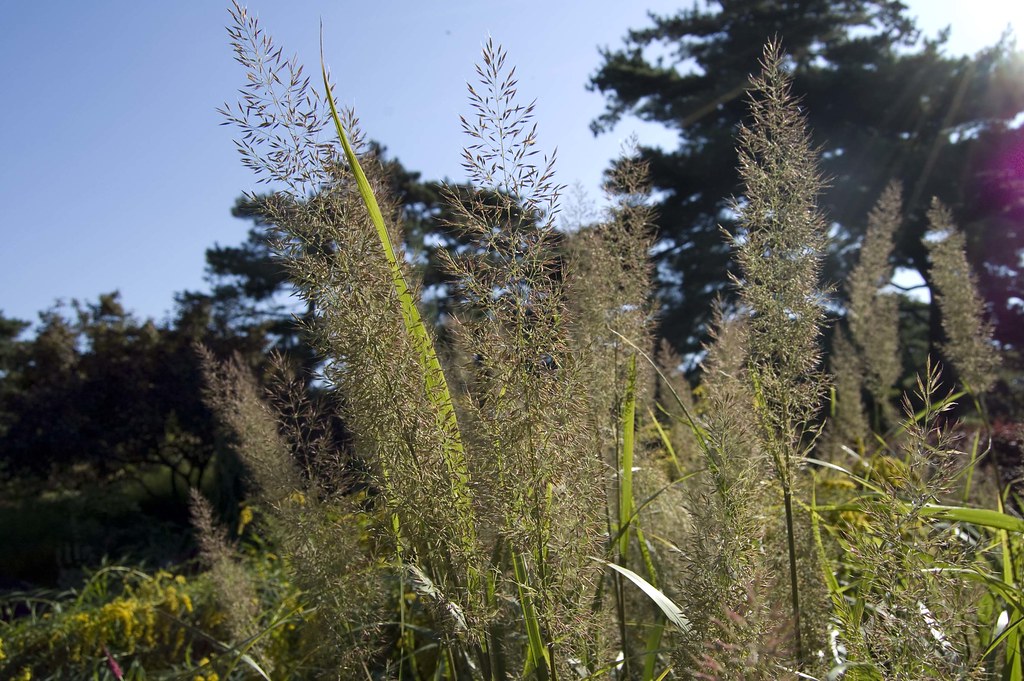 I was fortunate enough to spend two weeks in the Southeast of England this past July. As I toured around a handful of gardens, one thing that made a lasting impression was the size of the plants. With their cool summers and ample rainfall, perennials that grow three feet tall in the New York area were happily stretching up to four or five feet.
I was fortunate enough to spend two weeks in the Southeast of England this past July. As I toured around a handful of gardens, one thing that made a lasting impression was the size of the plants. With their cool summers and ample rainfall, perennials that grow three feet tall in the New York area were happily stretching up to four or five feet.
On this side of the pond the past year felt distinctly British. Spring lasted for more than a quick two-week spell with the cool weather and rain that extended well into May. July certainly had periods that were hot and the rains came infrequently in heavy downpours; the tropical plants in the Garden took notice and jumped into their full glory. August surprised me. Instead of the stifling heat and insufferable humidity that I have grown accustomed to, it was pleasant. The intense heat never came.
These are the moments that I wish I had a crystal ball. Had I known this ahead of time, I would have filled my perennial borders with lupines, penstemons, and delphiniums. I would have also cut back some of my larger, floppier customers such as the Montauk daisy (Nipponantheum) even harder than I normally do.
The ornamental grasses grew taller than I was accustomed to and needed more staking than in previous years. Many plants doubled in size and spread happily through the garden. My catmint (Nepeta) lost its sense of time and did not know when to stop flowering. Along with the lavender, it sent up sporadic blooms through the summer and well into fall. My Virginia sweetspire (Itea) decided that fall had come early and started to show its fiery reds as early as mid-August.
Observation is one of the finest tools that gardeners can posses. Gardeners not only work with plants, they work with nature. Observing nature and watching how changes in the environment directs and affects the growth and the cycles in the garden is one of the greatest gifts. It teaches gardeners more about plants than any textbook ever could.
Posted in Uncategorized on December 23 2008, by Plant Talk
Posted in Gardening Tips on December 22 2008, by Sonia Uyterhoeven
Lessons in Biodiversity and Sense of Place
 Sonia Uyterhoeven is Gardener for Public Education at The New York Botanical Garden.
Sonia Uyterhoeven is Gardener for Public Education at The New York Botanical Garden.
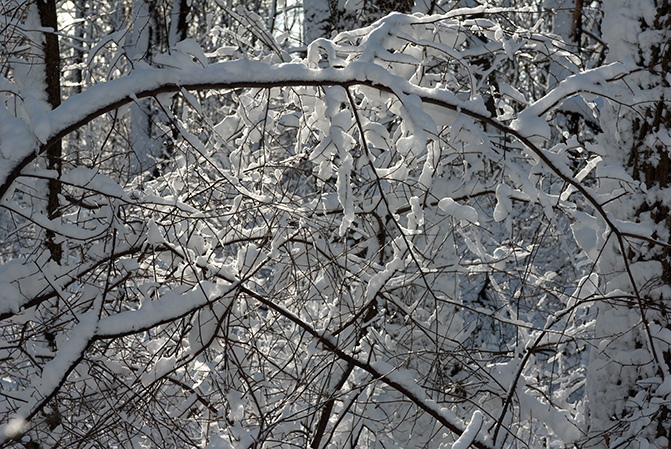 I recently attended a lecture on the art of ecological garden design and found a great deal of inspiration from the speaker’s ideology. I was reminded of the importance of a “sense of place.”
I recently attended a lecture on the art of ecological garden design and found a great deal of inspiration from the speaker’s ideology. I was reminded of the importance of a “sense of place.”
This is a design concept that has been around for years, but it was forcefully driven home with the reminder that a generic landscape—let’s say for the sake of simplicity a home surrounded by a green lawn—gives the viewer no sense of locality. You could be in Arizona, Alaska, Alabama, or anywhere in between.
With it comes the poignant reminder that we “no longer know where we are” and lose a sense of “who we are.” There is a loss of culture and tradition that disappears with the absence of locality.
Every part of the country has its own particular flavor.
If you are looking out your window and you see the knobby trunk of a pitch pine (Pinus rigidia), a beach plum (Prunus maritima), and expansive carpets of bearberry (Arctostaphylos uva-ursi) and broom crowberry (Corema conradii) covering sandy soil, then you are probably on Cape Cod. This is an image that is laden for many with certain associations, smells, and memories—generally good ones.
It is a memory of a diverse environment. This guru on ecological garden design reminded me that the experientially rich environment is full of textures, colors, movement, and sounds. With diverse plant palates comes the concomitant diversity in wildlife—the welcome as well as the unwelcome kind.
Monocultures often appear to be static and sterile, while one of the greatest joys of a natural environment is its dynamic system that celebrates seasonality. If beauty and abundance is not enough to convince the reader of the importance of diversity, then know that an ecological garden works with its surrounding rather than against it so is much less of a maintenance challenge. It certainly doesn’t require the quantity of chemicals that we have to dump into our lawns to keep them green.
Does this mean we should do away with the generic lawn? Certainly not! I would hate to lose the spot for the lawn chair, the badminton game, or the barbeque. With a little planning we can have the best of both worlds—patches of organically maintained lawn woven into a diverse and ecologically sound garden. This is how we can flourish and grow into the future.
Posted in Learning Experiences, Shop/Book Reviews on December 19 2008, by Plant Talk
Recipes for Holiday Gift Giving
 John Suskewich is Book Manager for Shop in the Garden.
John Suskewich is Book Manager for Shop in the Garden.
See the high accolades given to the Shop’s book section by the Financial Times of London.

I suffer from an edible complex: I am always thinking about eating! So I find myself irresistibly drawn to the food section of the bookstore, checking out the display copies of new cookbooks to see how the recipes stack up: One of the perks of the clerk. This is how I’ve come up with a number of recommendations for holiday gift giving for the foodies in your family!
Anyone who looks forward to putting on their annual winter layer of fat will be pleased with A Year in Chocolate. In this month-by-month guide to cooking with cacao, noted New York chocolatier Jacques Torres has adapted for the home cook his exquisite, indulgent desserts full of butter and cream with explicit but not complicated instructions. I love fine eating, but I still ignored all the ones that called for tempered chocolate and headed right for the brownies and the poached pears with chocolate sauce. The chocolate cookie that includes ancho chili powder among the ingredients is a real sweet slap in the face!
 Okay, the New York dead of winter is not the right time to think of farmers markets, but Outstanding in the Field, by Jim Denevan, with its seasonal and market-based recipes, summons up summer in a dish so evocatively you’ll be living in July in perpetuity. These recipes derive from the impromptu farm dinners created by Mr. Denevan and his fellow foodies for their unique, eponymous organization Outstanding in the Field, which goes across the country creating locavore versions of ’60s-style happenings, eat-ins maybe? I don’t know if they’ll ever come to the Bronx, but you can re-create the experience with the corn chowder, spinach gnocchi, and the free-range chicken dishes described here. Not until the roast turkey do you find a recipe that goes on for more than two pages. But if you’re like me you’ll read it, think “How interesting,” and then accept the invitation to dine at your sister’s for the holiday feast.
Okay, the New York dead of winter is not the right time to think of farmers markets, but Outstanding in the Field, by Jim Denevan, with its seasonal and market-based recipes, summons up summer in a dish so evocatively you’ll be living in July in perpetuity. These recipes derive from the impromptu farm dinners created by Mr. Denevan and his fellow foodies for their unique, eponymous organization Outstanding in the Field, which goes across the country creating locavore versions of ’60s-style happenings, eat-ins maybe? I don’t know if they’ll ever come to the Bronx, but you can re-create the experience with the corn chowder, spinach gnocchi, and the free-range chicken dishes described here. Not until the roast turkey do you find a recipe that goes on for more than two pages. But if you’re like me you’ll read it, think “How interesting,” and then accept the invitation to dine at your sister’s for the holiday feast.
 There is no point in trying to ignore the Barefoot Contessa, a.k.a. Ina Garten, whose latest cookbook is Back to Basics. She is as irresistible as the brownie pudding there on page 218. The subtitle is “fabulous flavor from simple ingredients,” but it is the element of subtle sophistication that sets her recipes apart. BC’s BLTs add avocado; roasting replaces poaching in her shrimp cocktail; caramelized onions fillip the burger. When she says “This version has always been my favorite but…” and then she tweaks it with one ingredient or maybe two, or some technical change…and the dish is transformed! She makes it look easy, but that inventiveness takes years of practice.
There is no point in trying to ignore the Barefoot Contessa, a.k.a. Ina Garten, whose latest cookbook is Back to Basics. She is as irresistible as the brownie pudding there on page 218. The subtitle is “fabulous flavor from simple ingredients,” but it is the element of subtle sophistication that sets her recipes apart. BC’s BLTs add avocado; roasting replaces poaching in her shrimp cocktail; caramelized onions fillip the burger. When she says “This version has always been my favorite but…” and then she tweaks it with one ingredient or maybe two, or some technical change…and the dish is transformed! She makes it look easy, but that inventiveness takes years of practice.
There you go. We’re really into food this season, and we’ll be expanding the selection as we ramp up to our big summer show on edible gardens. Stay tuned for details. Can’t wait for the okra to come in!
For more gift-giving ideas, view the Shop in the Garden staff’s favorite picks.
Also the Holiday Train Show is in full swing!
Check out Saturday’s programming
Check out Sunday’s programming
Posted in Exhibitions, Gardens and Collections, Holiday Train Show on December 18 2008, by Plant Talk
 |
Karen Daubmann is Director of Exhibitions and Seasonal Displays. |
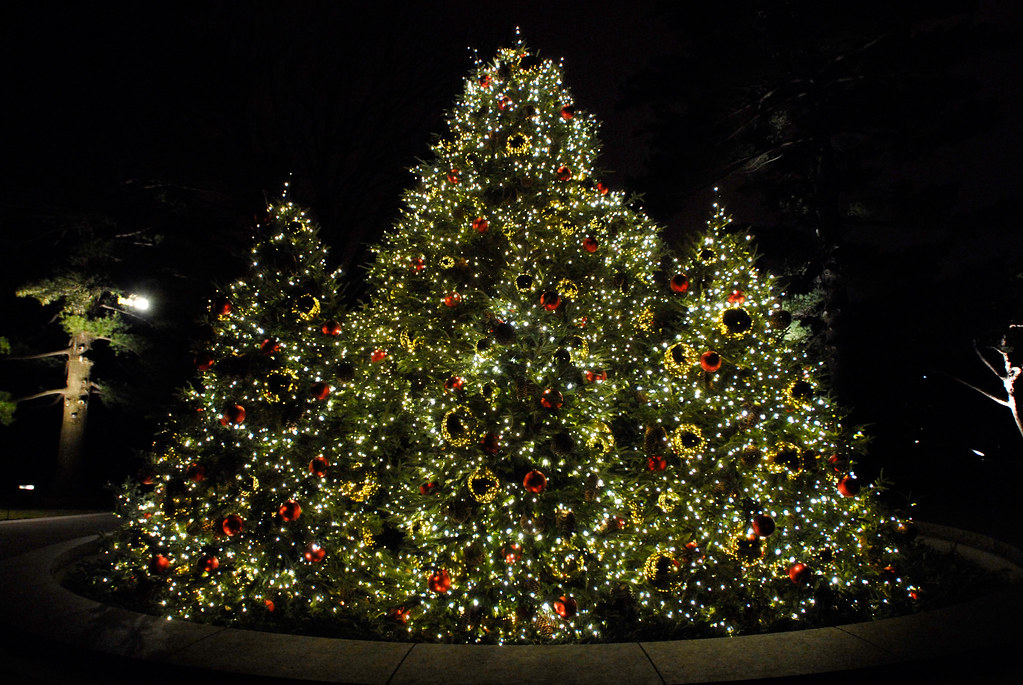 Planning for the holiday celebrations at the Garden starts long in advance. At this time last year the holiday display in the Reflecting Pool in the Leon Levy Visitor Center was evaluated and decisions were made concerning additions, deletions, and upgrades for this year’s display.
Planning for the holiday celebrations at the Garden starts long in advance. At this time last year the holiday display in the Reflecting Pool in the Leon Levy Visitor Center was evaluated and decisions were made concerning additions, deletions, and upgrades for this year’s display.
In August, our Director of Arboretum, Grounds, and Gardens, Kurt Morrell, traveled to the mountains of North Carolina to select the trees that would be used. Since big trees are hard to come by, the location of the farm must be kept a secret. We use a 28-foot tree in the center, surrounded by eight smaller trees. Always working well in advance of each project, Kurt has earmarked several trees that are being groomed for the years to come. Fraser fir, Abies fraseri, is his tree of choice. It lasts well from mid-November through mid-January, has nice structure and color, and the branches are stiff enough to support the weight of the large ornaments and the huge pine cones, which are from Pinus lambertiana, sugar pine, native to California.
To reduce energy use, we decided to change over to LED lights this year; the orders had to be placed earlier than usual, beginning in early summer. The lights arrived by early autumn and awaited installation—more than 19,000 bulbs just for the Reflecting Pool trees. Vendors were selected for the lighting and the decorating, and all waited for the November 10 arrival of the trees, ready to put the plan in motion.
The trees left North Carolina early Saturday morning, November 8, on a special, extra-long trailer. They arrived at the Garden two mornings later and were met by a crew from the outdoor gardens staff and a large crane. After the trees were placed in special steel tree stands, the crew from Frost Lighting leaped into action. It took three days to add the LED light strings to the trees. Meanwhile, the crew from Bowman Dahl Floral and Event Design arrived to clean and prep the ornaments, both those that were recycled from past shows and those that would be new additions.
Just five days after delivery, the vignette of trees was ready for its unveiling.
Posted in Learning Experiences, Programs and Events on December 17 2008, by Plant Talk
 |
Jeff Downing is Vice President for Education. |
When I was a kid growing up in rural Newtown, Connecticut, my best friend, Cliff, and I climbed trees. We were good. We could shimmy, twist, and scamper our way to the highest branches that would support our meager weight. From there, we would survey the neighborhood like forest rangers as the treetop swayed. (We never understood why our moms cried in horror whenever they discovered us happily perched 30 feet above our roofs.) Those were the days.
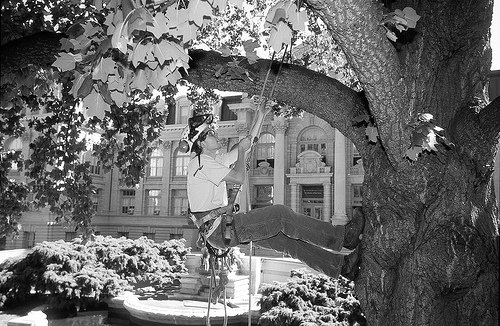 If someone had told me then that you could actually make a career out of climbing trees, I would have said, “Where do I sign up?” And now, when I speak with passionate recreational gardeners about the frustrating shortage of skilled horticulturists, many respond with similar wide-eyed surprise: “You mean I could do this for a living?”
If someone had told me then that you could actually make a career out of climbing trees, I would have said, “Where do I sign up?” And now, when I speak with passionate recreational gardeners about the frustrating shortage of skilled horticulturists, many respond with similar wide-eyed surprise: “You mean I could do this for a living?”
But the fact is that arborists and horticulturists of every description are truly in demand, and have been for some time. Botanical gardens, municipal parks departments, estate managers, and landscape design/building firms all lament the shortage of trained professionals, from entry level gardeners to horticulture directors and executives. And the best I can figure, it is largely for lack of public awareness that these career tracks actually exist!
The New York Botanical Garden’s Continuing Education program and School of Professional Horticulture have trained generations of the world’s finest horticulturists for over 80 years. Now, certificates are offered in seven disciplines, including horticulture, landscape design, floral design, and horticultural therapy.
But in this economy, will there be jobs? I can’t tell the future, but I know the history—too few trained professionals for too long. And I know the present—trees still need to be pruned, gardens still need love and care. Look up the New York City Parks Department’s Career Opportunities, for just one example. Then go to our Continuing Education Web page and register online for an introductory class (or call us at 1-800-322-NYBG for guidance). The Garden’s classes are like potato chips: I bet you can’t take just one.
Posted in NYBG in the News on December 16 2008, by Plant Talk
 Carol Capobianco is Editorial Content Manager at The New York Botanical Garden.
Carol Capobianco is Editorial Content Manager at The New York Botanical Garden.
 Each day in the media we are made aware of the harm being done to the environment due to climate change, invasive species, overuse of natural resources, and clear-cutting of forests. Gardeners can make a difference—in the way they design and manage the landscape.
Each day in the media we are made aware of the harm being done to the environment due to climate change, invasive species, overuse of natural resources, and clear-cutting of forests. Gardeners can make a difference—in the way they design and manage the landscape.
Today, Plant Talk introduces a companion blog, Green Perspectives: Tom Christopher on Sustainable Gardening, to offer gardeners solutions and ideas on how to help the environment. Veteran garden writer Tom Christopher has been gardening and writing for more than 30 years and is a graduate of NYBG’s School of Professional Horticulture. He will take you along with him as he explores, investigates, and tests different ways and methods of restoring Earth through our passion for earth.
The New York Botanical Garden, as a premier plant research and cultural institution, is working to address conservation concerns both here at the Garden and around the world. The Garden’s sustainability and climate change initiatives include improving operational efficiencies and energy use, reviewing horticultural practices, presenting educational programs and symposia, conducting biodiversity research, and providing scientific advice to conservation organizations.
To find Tom Christopher’s blog posts, click on the “Green Perspectives” tab above. Be sure to visit often and to share your comments. Let us know what has worked for you. Together we can make a difference.





 I recently attended a lecture on the art of ecological garden design and found a great deal of inspiration from the speaker’s ideology. I was reminded of the importance of a “sense of place.”
I recently attended a lecture on the art of ecological garden design and found a great deal of inspiration from the speaker’s ideology. I was reminded of the importance of a “sense of place.”






 If someone had told me then that you could actually make a career out of climbing trees, I would have said, “Where do I sign up?” And now, when I speak with passionate recreational gardeners about the frustrating shortage of skilled horticulturists, many respond with similar wide-eyed surprise: “You mean I could do this for a living?”
If someone had told me then that you could actually make a career out of climbing trees, I would have said, “Where do I sign up?” And now, when I speak with passionate recreational gardeners about the frustrating shortage of skilled horticulturists, many respond with similar wide-eyed surprise: “You mean I could do this for a living?”
